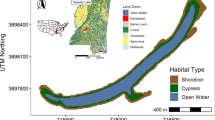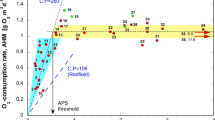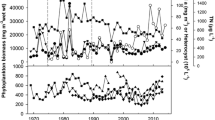Abstract
Quantifying net N2 flux, the balance between nitrogen (N) fixation and denitrification, may help inform the decades-long debate about the significance of N relative to phosphorus (P) limitation in pond, lake, and reservoir ecosystems. Dissolved N2:Ar ratios can provide information about the role of these two processes in lakes but have not been experimentally verified. We measured dissolved N2:Ar patterns in twelve experimental pond mesocosms representing a N:P gradient ranging from 7 to 835 (molar) that was driven by large differences in NO3-N availability. Mesocosms with NO3-N < 0.1 mg L−1 had N2:Ar saturation ratio values consistently below equilibrium (i.e., net N fixation), whereas mesocosms with NO3-N > 1 mg L−1 had N2:Ar values consistently above equilibrium (i.e., net denitrification, demonstrating a shift from N2 import to export as pond N availability increased). Both planktonic N fixation estimated from isotope mixing models and N2 fluxes measured by sediment core incubations confirmed a shift from net N fixation to net denitrification as NO3-N concentrations increased. N2:Ar saturation ratio values in the photic zone were negatively correlated with increasing measured N fixation while saturation ratios from benthic waters were positively correlated with increasing sediment N2-N flux. N2:Ar saturation ratios were consistently < 1 in mesocosms with low N availability and high contributions of fixed N. Mesocosms with high N loading and low N fixation had high saturation ratios indicative of denitrification in benthic samples but dissolved gases collected from the photic zone were less consistent. Our water column N2:Ar saturation ratio measurements combined with quantitative measures of N fixation and benthic N2 flux confirm that grab samples for dissolved gasses can provide critical information regarding the relative contribution of net N fixation and denitrification to balancing N availability within shallow lakes at broad scales.





Similar content being viewed by others
Data availability
The datasets generated during and/or analysed during the current study are available from the corresponding author on reasonable request.
References
APHA (American Public Health Association) (2005) Standard methods for the analysis of water and wastewater, 21st edn. American Public Health Association, American Water Works Association, & Water Environment Federation, Washington, DC
Baker BC, Wilson AE, Scott JT (2018) Phytoplankton N2-fixation efficiency and its effect on harmful algal blooms. Freshw Sci 37:264–275. https://doi.org/10.1086/697530
Bauersachs T, Schouten S, Compaoré J, Wooenzien U, Stal LJ, Sinninghe Damsté JS (2009) Nitrogen isotopic fractionation associated with growth on dinitrogen gas and nitrate by cyanobacteria. Limnol Oceanogr 54:1403–1411
Bernhardt ES, Heffernan JB, Grimm NB, Stanley EH, Harvey JW, Arroita M, Appling AP, Cohen MJ, McDowell WH, Hall RO Jr, Read JS, Roberts BJ, Stets EG, Yackulic CB (2018) The metabolic regimes of flowing waters. Limnol Oceanogr 63:99–118. https://doi.org/10.1002/lno.10726
Bernhardt ES, Savoy P, Vlah MJ, Appling AP, Koenig LE, Hall RO Jr, Grimm NB (2022) Light and flow regimes regulate the metabolism of rivers. Proc Natl Acad Sci USA 119:e2121976119. https://doi.org/10.1073/pnas.2121976119
Boedecker AR, Niewinski DN, Newell SE, Chaffin JD, McCarthy MJ (2020) Evaluating sediments as an ecosystem service in western Lake Erie via quantification of nutrient cycling pathways and selected gene abundances. J Great Lakes Res 46:920–932. https://doi.org/10.1016/j.jglr.2020.04.010
Burgin AJ, Hamilton SK (2007) Have we overemphasized the role of denitrification in aquatic ecosystems? A review of nitrate removal pathways. Front Ecol Environ 5:89–96. https://doi.org/10.1890/1540-9295
Deemer BR, Harrison JA, Whitling EW (2011) Microbial dinitrogen and nitrous oxide production in a small eutrophic reservoir: an in-situ approach to quantifying hypolimnetic process rates. Limnol Oceanogr 56:1189–1199. https://doi.org/10.4319/lo.2011.56.4.1189
Del Giorgio PA, Cole JJ, Caraco NF, Peters RH (1999) Linking planktonic biomass and metabolism to net gas fluxes in northern temperate lakes. Ecology 80:1422–1431. https://doi.org/10.1890/0012-9658(1999)080[1422:LPBAMT]2.0.CO;2
Elser JJ, Bracken MES, Cleland EE, Gruner DS, Harpole WS, Hillebrand H, Ngai JT, Seabloom EW, Shurin JB, Smith JE (2007) Gloabla analysis of nitrogen and phosphorus limitation of primary producers in freshwater, marine and terrestrial ecosystems. Ecol Lett 10:1135–1142
Eyre BD, Rysgaard S, Dalsgaard T, Christensen PB (2002) Comparison of isotope pairing and N2: Ar methods for measuring sediment denitrification: assumptions, modifications, and implications. Estuaries 25:1077–1087
Finlay JC, Kendall C (2007) Stable isotope tracing of temporal and spatial variability in organic matter sources to freshwater ecosystems. In: Michener R, Lajtha K (eds) Stable isotopes in ecology and environmental science, 2nd edn. Blackwell Publishing, Malden
Finlay JC, Small GE, Sterner RW (2013) Human influences on nitrogen removal in lakes. Science 342:247–250
Gardner WS, McCarthy MJ, An S, Sobolev D, Sell KS, Brock D (2006) Nitrogen fixation and dissimilatory nitrate reduction to ammonium (DNRA) support nitrogen dynamics in Texas estuaries. Limnol Oceanoagr 51:558–568
Grantz EM, Kogo A, Scott JT (2012) Partioning whole-lake denitrification using in situ dinitrogen gas accumulation and intact sediment core experiments. Limnol Oceanogr 57:925–935. https://doi.org/10.4319/lo.2012.57.4.0925
Grantz EM, Haggard BE, Scott JT (2014) Stoichiometric imbalance in rates of nitrogen and phosphorus retention, storage, and recycling can perpetuate nitrogen deficiency in highly productive reservoirs. Limno Oceanogr 59:2203–2216
Groffman PM, Altabet MA, Böhlke JK, Butterbach-Bahl K, David MB, Firestone MK, Giblin AE, Kana TM, Nielsen LP, Voytec MA (2006) Methods for measuring denitrification: diverse approaches to a difficult problem. Ecol Apps 16:2091–2122
Groffman PM, Butterbach-Bahl K, Fulweiler RM, Gold AJ, Morse JL, Stander EK, Tague C, Tonitto C, Vidon P (2009) Challenges to incorporating spatially and temporally explicit phenomena (hotspots and hot moments) in denitrification models. Biogeochemistry 93:49–77
Grover JP, Scott JT, Roelke DL, Brooks BW (2021) Competitive superiority of N-fixing cyanobacteria when fixed N is scarce: reconsiderations based on a model with heterocyst differentiation. Ecol Model 466:109904
Harrison JA, Maranger RJ, Alexander RB, Giblin AE, Jacinthe PA, Mayorga E, Seitzinger SP, Sobota DJ, Wollheim WM (2009) The regional and global significance of nitrogen removal in lakes and reservoirs. Biogeochemistry 93:143–157
Hayes NM, Patoine A, Haig HA, Simpson GL, Swarbrick VJ, Wiik E, Leavitt PR (2018) Spatial and temporal variation in nitrogen fixation and its importance to phytoplankton in phosphrous-rich lakes. Freshw Biol 64:269–283. https://doi.org/10.1111/fwb.13214
Higgins SN, Paterson MJ, Hecky RE, Schindler DW, Venkiteswaran JJ, Findlay DL (2017) Biological nitrogen fixation prevents the response of a eutrophic lake to reduced loading of nitrogen: evidence from a 46-year whole-lake experiment. Ecosystems 21:1088–1100
Hoellein TJ, Bruesewitz DA, Richardson DC (2013) Revisiting Odum (1956): A synthesis of aquatic ecosystem metabolism. Limno Oceanogr 58:2089–2100. https://doi.org/10.4319/lo.2013.58.6.2089
Holgerson MA, Richardson DC, Roith J, Bortolottii LE, Finlay K, Hornbach DJ et al (2022) Classifying mixing regimes in ponds and shallow lakes. Water Resour Res 58:e20222WR032522. https://doi.org/10.1029/2022WR032522
Holocher J, Peeters F, Aeschbach-Hertig W, Kinzelbach W, Kipfer R (2003) Kinetic model of gas bubble dissolution in groundwater and its implications for the dissolved gas composition. Environ Sci Technol 37:1337–1343
Jankowski K, Schindler DE, Holtgrieve GW (2012) Assessing nonpoint-source nitrogen loading and nitrogen fixation in lakes using δ15N and nutrient stoichiometry. Limnol Oceanogr 57:671–683. https://doi.org/10.4319/lo.2012.57.3.0671
Jankowski JK, Mejia FH, Blaszczak JR, Holtgrieve GW (2021) Aquatic ecosystem metabolism as a tool in environmental management. Wires Water 2021:e1521. https://doi.org/10.1002/wat2.1521
Kana TM, Darkangelo C, Hunt MD, Oldham JB, Bennett GE, Cornwell JC (1994) Membrane inlet mass spectrometer for rapid high-precision determination of N2, O2, and Ar in environmental water samples. Anal Chem 66:4166–4170
Kelly PT, Taylor JM, Andersen IM, Stovall J, Scott JT (2021) Highest primary production achieved at high nitrogen levels despite strong stoichiometric imbalances with phosphorus in hypereutrophic experimental systems. Limno Oceanogr 66:4375–4390
Kendall C, Elliott EM, Wankel SD (2007) Tracing anthropogenic inputs of nitrogen to ecosystems. In: Michener R, Lajtha K (eds) Stable isotopes in ecology and environmental science, 2nd edn. Blackwell Publishing, Malden
Ladwig R, Appling AP, Delany A, Dugan HA, Gao Q, Lottig N, Stachelek J, Hanson PC (2022) Long-term change in metabolism phenology in north temperate lakes. Limnol Oceanogr 67:1502–1521. https://doi.org/10.1002/lno.12098
Laursen AE, Seitzinger SP (2002) Measurement of denitrification in rivers: an integrated, whole reach approach. Hydrobiologia 487:67–81
Length RV, Buerkner P, Giné-Vázquez I, Herve M, Jung M, Love J, Miguez F, Riebl H, Singmann H, R Core team (2022) emmeans. R package version 1.8.3, https://cran.r-project.org/web/packages/emmeans/index.html.
Lewis WM Jr, Wurtsbaugh WA (2008) Control of lacustrine phytoplankton by nutrients: erosion of the phosphorus paradigm. Int Rev Hydrobiol 93:446–465
Loeks BM, Cotner JB (2020) Upper Midwest lakes are supersaturated with N2. Proc Natl Acad Sci USA 117:17063–17067. https://doi.org/10.1073/pnas.1921689117
Marcarelli AM, Fulweiler RW, Scott JT (2022) Nitrogen fixation: a poorly understood process along the freshwater–marine continuum. Limno Oceanogr Lett 7:1–10. https://doi.org/10.1002/lol2.10220
Molot LA, Higgins SN, Schiff SL, Venkiteswaran JJ, Paterson MJ, Baulch HM (2021) Phosphorus-only fertilization rapidly initiates large nitrogen-fixing cyanobacterial blooms in two oligotrophic lakes. Environ Res Lett 16:064078. https://doi.org/10.1088/1748-9326/ac0564
Moon D, Scott JT, Johnson TR (2021) Stoichiometric imbalances complicate prediction of phytoplankton biomass in US lakes: implications for nutrient criteria. Limnol Oceanogr 66:2967–2978
Mulholland PJ, Helton AM et al (2008) Stream denitrification across biomes and its response to anthropogenic nitrate loading. Nature 452:202–205
Mulholland PJ, Hall RO Jr, Sobota DJ, Dodds WK, Findlay SEG, Grimm NB, Hamilton SK, McDowell WH, O’Brien JM, Tank JL, Ashkenas LR, Cooper LW, Dahm CN, Gregory SV, Johnson SL, Meyer JL, Peterson BJ, Poole GC, Valette HM, Webster JR, Arango CP, Beaulieu JJ, Bernot MJ, Burgin AJ, Crenshaw CL, Helton AM, Johnson LT, Niederlehner BR, Potter JD, Sheibley RW, Thomas SM (2009) Nitrate removal in stream ecosystems measured by 15N addition experiments: Denitrification. Limnol Oceanogr 54:666–680. https://doi.org/10.4319/lo.2009.54.3.0666
Nifong RL, Taylor JM, Moore MT (2019) Mulch-derived organic carbon stimulates high denitrification fluxes from agricultural ditch sediments. J Environ Qual 35:1135–1144
Nifong RL, Taylor JM, Adams G, Moore MT, Farris JL (2020) Recognizing both denitrification and nitrogen consumption improves performance of stream diel N2 flux models. Limnol Oceanogr 18:169–182
Nifong RL, Taylor JM, DeVilbiss S (2022) Spatial and temporal patterns of benthic nutrient cycling define the extensive role of internal loading in an agriculturally influenced oxbow lake. Biogeochemistry 159:413–433
Paerl HW, Scott JT, McCarthy MJ, Newell SE, Gardner W, Havens KE, Wurtsbaugh WA (2016) It takes two to tango: when and where dual nutrient (N & P) reductions are needed to protect lakes and downstream ecosystems. Environ Sci Techol 50:10805–10813. https://doi.org/10.1021/acs.est.6b02575
Palacin-Lizarbe C, Camarero L, Hallin S, Jones CM, Catalan J (2020) Denitrification rates in lake sediments of mountains affected by high atmospheric nitrogen deposition. Sci Rep 10:3003. https://doi.org/10.1038/s41598-020-59759-w
Pinheiro J, Bates D, DebRoy S, Sarkar D, R Core team (2020) nlme: linear and nonlinear mixed effects models. R package version 3.1–150. https://CRAN.r-project.org/pacage=nlme
R Core Team (2022). R: A language and environment for statistical computing. R Foundation for Statistical Computing, Vienna, Austria. https://www.R-project.org/
Reed JS, Hamilton DP, Desai AR, Rose KC, MacIntyre S, Lenters JD, Smyth RL, Hanson PC, Cole JJ, Staehr PA, Rusak JA, Pierson DC, Brookes JD, Laas A, Wu CH (2012) Geophys Res Letters 39:L09405. https://doi.org/10.1029/2012GL051886
Reisinger AJ, Tank JL, Hoellein TJ, Hall RO Jr (2016) Sediment, water column, and open-channel denitrification in rivers measured using membrane-inlet mass spectrometry. J Geophys Res Biogeo 121:1258–1274
Schindler DW, Hecky RE, Findlay DL, Stainton MP, Parker BR, Paterson MJ, Kasain SEM (2008) Eutrophication of lakes cannot be controlled by reducing nitrogen input: results of a 37-year whole-ecosystem experiment. Proc Natl Acad Sci USA 105:11254–11258. https://doi.org/10.1073/pnas.0805108105
Schindler DW, Carpenter SR, Chapra SC, Hecky RE, Orihel DM (2016) Reducing phosphorus to curb lake eutrophication is a success. Environ Sci Techol 50:8923–8929. https://doi.org/10.1021/acs.est.6b02204
Scott JT, Grantz EM (2013) N2 fixation exceeds internal nitrogen loading as a phytoplankton nutrient source in perpetually nitrogen-limited reservoirs. Freshw Sci 32:849–861
Scott JT, McCarthy MJ (2010) Nitrogen fixation may not balance the nitrogen pool in lakes over timescales relevant to eutrophication management. Limnol Oceanogr 55:1265–1270
Scott JT, McCarthy MJ, Paerl HW (2019) Nitrogen transformations differentially affect nutrient-limited primary production in lakes of varying trophic state. Limno Oceanogr Lett 4:96–104. https://doi.org/10.1002/lol2.10109
Seitzinger S, Harrison JA, Bohlke JK, Bouwman AF, Lowrance R, Peterson B, Tobias C, Van Drecht G (2006) Denitrification across landscapes and waterscapes: a synthesis. Ecol Appl 16:2064–2090
Shi W, Zhu L, Van Dam B, Smyth AR, Deng J, Zhou J, Pan G, Yi Q, Jianghua U, Qin B (2022) Wind induced algal migration manipulates sediment denitrification N loss patterns in shallow Taihu Lake, China. Water Res 209:117887. https://doi.org/10.1016/j.watres.2021.117887
Stelzer RS, Scott JT, Bartsch LA, Parr T (2014) Particulate organic matter quality influences nitrate retention and denitrification in stream sediments: evidence from a carbon burial experiment. Biogeochemistry 119:387–402
Sterner RW (2008) On the phosphorus limitation paradigm for lakes. Int Rev Hydrobiol 93:433–445. https://doi.org/10.1002/iroh.200811068
Taylor JM, Moore MT, Scott JT (2015) Contrasting nutrient mitigation and denitrification potential of agricultural drainage environments with different emergent macrophytes. J Environ Qual 44:1304–1314
USEPA (2016) National lakes assessment 2012: A collaborative survey of lakes in the United States. EPA 841-R-16-113. US Environmental Protection Agency.
Vachon D, Prairie YT (2013) The ecosystem size and shape dependence of gas transfer velocity versus wind speed relationships in lakes. Can J Fish Aquat Sci 70:1757–1764. https://doi.org/10.1139/cjfas-2013-0241
Vanni MJ, Renwick WH, Bowling AM, Horgan MJ, Christian AD (2011) Nutrient stoichiometry of linked catchment-lake systems along a gradient of land use. Freshw Biol 56:791–811. https://doi.org/10.1111/j.1365-2427.2010.02436.x
Vrede T, Ballantyne A, Mille-Lindbolm C, Algesten G, Gudasz C, Lindahl S, Brungerg AK (2009) Effects of N:P loading ratios on phytoplankton community composition, primary production and N fixation in a eutrophic lake. Freshw Biol 54:331–344. https://doi.org/10.1111/j.1365-2427.2008.02118.x
Weiss RF (1970) The solubility of nitrogen, oxygen and argon in water and seawater. Deep-Sea Res 17:721–735
Xia X, Jia Z, Liu T, Zhang S, Zhang L (2017) Coupled nitrification-denitrification caused by suspended sediments (SPS) in rivers: importance of SPS size and composition. Environ Sci Technol 51:212–221
Zhang W, Hengpeng L, Pueppke SG (2022) Direct measurements of dissolved N2 and N2O highlight the strong nitrogen (N) removal potential of riverine wetlands in a headwater stream. Sci Total Environ 848:157538. https://doi.org/10.1016/j.scitotenv.2022.157538
Zuur AF, Ieno EN, Walker N, Saveliev AA, Smith GM (2009) Mixed effects models and extension in ecology with R. Springer, New York
Acknowledgements
We would like to thank the University of Mississippi Biological Field Station, particularly Scott Knight, for providing research ponds, maintenance, and logistical support for establishing pond mesocosm experimental design. Sam Testa, Bryson Nobles, Bo Nash, Terry Welch, and Mark Baker provided significant effort installing mesocosms and building docks. Victoria Simek and Alanna Strauss were integral to maintaining dosing, water quality sampling, and MIMS analysis. Steve Powers helped with sediment core collection and incubation. The Center for Reservoir and Aquatic Systems Research at Baylor University (Jeff Back) analyzed dissolved and total nutrient samples. This work was improved through review comments provided by Stephen DeVilbiss, Caleb Robbins, A. J. Reisinger, and one anonymous reviewer. Mention of trade names or commercial products in this publication is solely for the purpose of providing specific information and does not imply recommendation or endorsement by the USDA. USDA is an equal opportunity provider and employer.
Funding
This research was supported by the US Department of Agriculture, Agricultural Research Service.
Author information
Authors and Affiliations
Contributions
All authors contributed to the study conception and design. Material preparation and data collection were performed by Jason M. Taylor, Isabelle M. Andersen, Alexa K. Hoke, Patrick T. Kelly, and J. Thad Scott. Data analyses were performed by Jason M. Taylor, Isabelle M. Andersen and J. Thad Scott. The first draft of the manuscript was written by Jason M. Taylor and J. Thad Scott and all authors commented on previous versions of the manuscript. All authors read and approved the final manuscript.
Corresponding author
Ethics declarations
Conflict of interest
The authors declare that they have no conflict of interest.
Additional information
Responsible Editor: Robinson W Fulweiler.
Publisher's Note
Springer Nature remains neutral with regard to jurisdictional claims in published maps and institutional affiliations.
Supplementary Information
Below is the link to the electronic supplementary material.
Rights and permissions
About this article
Cite this article
Taylor, J.M., Andersen, I.M., Hoke, A.K. et al. In-situ N2:Ar ratios describe the balance between nitrogen fixation and denitrification in shallow eutrophic experimental lakes. Biogeochemistry 166, 283–301 (2023). https://doi.org/10.1007/s10533-023-01063-6
Received:
Accepted:
Published:
Issue Date:
DOI: https://doi.org/10.1007/s10533-023-01063-6




